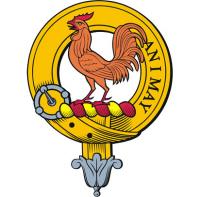
Clan Lyle
As early as the start of the 1200s a family of Lyles were barons of Duchal in Refrewshire.
The name Lyle is part of the same stock as the Northumberland family of 'de Insula' (as it is in Latin) 'Lisle' (de Lisle, Delisle in French).
Ralph de Insula, or Radulphus, is the first of this name to appear in Scotland. A follower of the Steward, around 1170, he witnessed the church of Innerkyp being gifted by Baldwin de Birge, the sheriff of Lanharc (Lanark), to the monks of Paisley. Around the same time, de Insula also witnessed the giving of ferms of his mill at Paisley by Walter Fitz-Alan for the soul of Sir Robert de Brus.
He witnessed, at some point prior to 1177, the church of Cragyn (Craigie in Kyle) being given to the monks of Paisley by Walter Hose.
Along with many of Scotland's nobility in 1296, John del Ille of Berwickshire, and Richard del Isle signed the Ragman Roll, pledging their allegience to England's Edward I.
James II (1437-1460) made Sir Robert Lyle a Lord, raising his knighthood to a peerage. The second Lord Lyle was appointed as embassador to England in 1472. He was also said to have witnessed the alledged murder of James III (1460-1488) at the 1488 Battle of Sauchieburn. It is said that Lord Lyle was so mortified by the regicide of his king that he, along with other nobles, including the Earl of Lennox, decided to take up arms to avenge the supposed murder of James II. However, this was not successful, and the title of Lord Lyle was forfeited the following year.
A Hercules Lyle fought in the 1745 rising, but died at the Battle of Falkirk in 1746.





